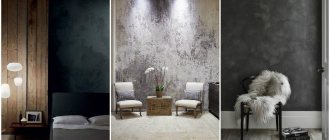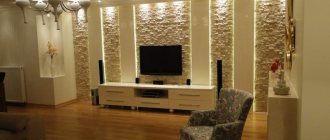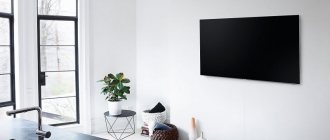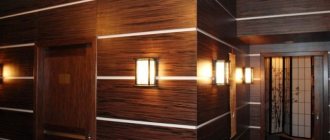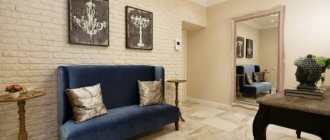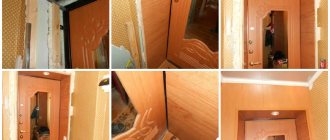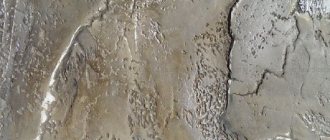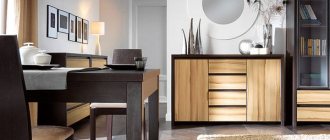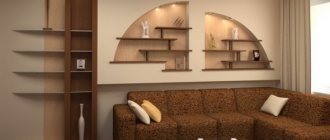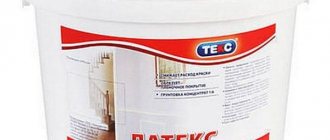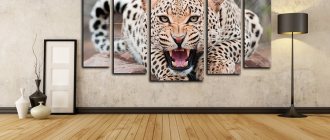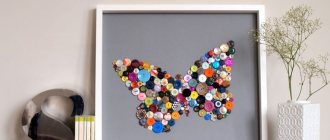Laminate is a well-known flooring material that is affordable and allows you to create a complete imitation of wood flooring. In practice, it can be used not only for floors, but also for wall decoration. This solution will give the interior an original and attractive style, but will also help level the surface of the wall if there are small imperfections on its surface.
pros
- Many texture solutions;
- Easy to install;
- Elimination of visual defects in walls;
- Durability during operation.
Minuses
- High cost of some models;
- Visual reduction of the room due to the wrong choice of textures.
Read more about the advantages and disadvantages
Laminate is a multilayer material made using natural wood, as well as PVC-based protective coatings, which give the material greater strength and resistance to external influences. when used as a wall material, it has the following advantages:
- Attractive appearance - available in a range of colors and textures. The finishing method itself is an original design move that attracts attention;
- Leveling the wall surface - if the wall in the hallway has defects, uneven corners, height differences and other imperfections, you can hide them by covering them with laminate;
- Resistance to all types of influences - since the material is used for flooring, it has high mechanical strength and is resistant to scratches and chips. Tolerates contact with water and humid environments well, does not fade in the sun, maintaining the original texture;
- It is easy to install - the technology for laying the coating is quite simple. When transferring it to the wall, not much changes and almost anyone can handle the installation.
Laminate has virtually no disadvantages as a finishing material for walls. It will last for many years due to its high wear resistance. It is easy to maintain and maintain, easy to wash and clean. To simplify maintenance, you can choose a material that has a special coating that prevents dust from settling on it.
Testing extreme conditions in the bathroom
A bathroom is a test of strength for any finishing material. This room is characterized by high humidity and temperature changes. In addition, water can get on the laminate surface.
Great combination of colors in the bedroom
Due to such difficult conditions, conventional laminate will not work. It is necessary to choose a material with increased moisture resistance.
It is important not to overdo it with a dark color if you are finishing not only the walls, but also the floor
It is expensive, but at the same time it will last a very long time, pleasing with its appearance. An ordinary one will not work - it may lose its appearance and warp.
Comparisons with other types of finishes
In addition to laminate, there are several varieties of other materials that allow you to create an original coating with a stylized wood texture. Let's look at them in more detail:
- Cladding with clapboard – clapboard is a wooden strip, planed and prepared for painting, 5 to 10 cm wide. It is attached to a wooden frame using nails or self-tapping screws. To decorate such coatings, painting with colored paints or applying transparent varnish is used to preserve the wood texture. The advantage of lining is its affordable cost, due to the fact that during production a minimum number of technical steps are used for its processing. The disadvantages include all the disadvantages inherent in natural wood. It is prone to deformation, expansion and drying out due to changes in temperature and humidity. Requires high-quality antiseptic treatment and a rather labor-intensive dyeing process. This coating is not relevant for every interior due to its simplicity;
- Covering with plastic panels - PVC panels are widely used in the interior and can be used in the hallway. This material is made in a texture that imitates natural wood in various colors and textures. It is lightweight and mounted on a wooden frame. The installation process takes a minimum of time, and the light weight of the material allows one person to work with it. The disadvantages of PVC panels include their fragility. Despite the manufacturer's assurances, it quickly fades in light, especially when exposed to UV radiation. Depending on the price, quality and operating conditions, the fading process takes from 2 to 5 years, after which the coating changes color or becomes faded. The plastic is quite fragile, scratches and chips appear on it even from mild mechanical influences, which significantly worsens the aesthetics of the material;
- Deck cladding is another wall finishing technology that uses flooring materials. The deck board is made of solid wood and has an aesthetic appearance and an attractive wood pattern. This finish is strong and durable, but at the same time, it weighs quite a lot and can only be attached to a permanent base. Among the disadvantages, one can highlight the high cost.
Finishing the wall with laminate in comparison with the listed materials provides the best combination of cost, quality and durability. When choosing a suitable method for originally decorating a room, you should think about laminate first.
Types of laminate for wall decoration
Decorative vinyl laminate
Vinyl is excellent for finishing rooms with high levels of humidity. It can even be installed in a bathroom or swimming pool. But does it have any disadvantages? It’s difficult to say, but a significant disadvantage of vinyl laminate is its high cost. The price is several times higher than the cost of conventional coverage.
High thermal insulation rates allow laminate flooring to be used both as a decorative element and as additional insulation.
There is one more disadvantage that not everyone knows about, so if you decide to go with this type of wall covering, you should know that it tends to fade in the sun.
Using blanks of the correct shape with specialized fasteners allows you to save time and money on installation work.
But at the same time its service life is more than 25 years. The only drawback is sunburn and the appearance of sun spots. It is for this reason that repairs may be necessary ahead of time. This drawback may not be significant when installed in a corridor, because most of this room has no windows at all. Despite the fact that laminate contains vinyl, it cannot be called a fireproof material.
You can do the finishing yourself without involving specialists.
Other
All laminate can be divided into two categories:
- clicky;
- adhesive.
When choosing, you should be guided by both your own preferences and the decisions of designers or aesthetic laws.
Adhesive laminate with smooth edges and no locks are provided on it. It is applied using liquid nails or silicone. Glue is applied to the wrong side, the part is laid, glue is applied to the end and a new part is placed in the same way. If glue begins to show between the edges, you can remove it with a sponge soaked in vinegar.
Laminate can be used both for finishing the entire room and a separate surface.
Under no circumstances should adhesive laminate be placed on the sheathing. It is not very suitable as a wall covering. It is more used as a floor covering.
Click laminate is a more modern type; it can be attached with glue even to the sheathing.
This is the most durable type that will last for many years.
In addition, laminate can be divided into two categories: moisture-resistant and water-resistant.
Waterproof laminate - this coating is completely resistant to moisture and is perfect for wall coverings in rooms with high levels of humidity. Even if flooding occurs, the laminate will hold water for six hours and only after this time will it begin to pass through.
Thanks to the treated locks, you can be sure that the wall covering will not let water through to your neighbors.
When purchasing panels for a corridor, we recommend that you go to a store that has a large number of good reviews. This ensures that you can purchase good quality material.
Decorating the entire room in one style is more suitable for small rooms.
When purchasing, you must inspect every detail, otherwise curved corners will spoil the appearance of the work. Please also take into account that during long-term storage the material can swell, that is, moisture accumulates in it.
In a large room, it is advisable to use laminate for finishing along with other materials.
Before purchasing, be sure to calculate how much you will need and make your purchase based on +10% of the material. It is very important that all the material is from the same batch, otherwise it may differ in color.
It is important to maintain harmony in the combination of colors. To do this, use similar shades or play with contrast.
Color selection
The selection of the color palette is carried out taking into account the color schemes present in the interior. You should rely on the following rules when choosing:
- In one room, especially one as small as a hallway, you cannot use more than 3 colors in decoration. Therefore, the laminate should be in the same color palette as other walls or decorative elements present;
- A light shade, for example, stained oak or ash, will visually enlarge the space. In rooms where there are no windows or natural light, light walls will reflect the incoming light, which will also improve the perception of the room;
- Dark colors in wenge or scrap wood visually move the walls, making the room smaller than it actually is. Therefore, this finish is recommended for large hallways where there is no shortage of free space. Dark wood worsens the distribution of natural light, since such a surface reflects the rays falling on it to a minimum extent;
- When decorating a room, you should not get carried away with the use of laminate and wood texture in general, especially dark shades. As a result, you can create the feeling of a wooden box and staying in the room will be uncomfortable. The optimal solution would be to finish one wall with laminate, painting or wallpapering the other walls of the room with a neutral pattern.
By adhering to the recommendations given, you can choose the appropriate color for finishing and avoid color or texture overload on the object.
Using laminate flooring in the bedroom and living room
The ideal place for laminate flooring in the bedroom is behind the bed. Using boards of different lengths and widths you can create a beautiful composition.
In the hall, laminate is used to highlight different zones. Most often this is the location of the TV, fireplace or seating area. The color is selected based on the furniture.
But consider which side of the world the room faces. If facing the north, then the room needs warm shades, and if facing the south, then cold shades.
Material
The list of materials required for installation depends on the chosen installation technology. In any case, the work will require the following minimum set of tools:
- Saw for cutting boards;
- Square and marker or pencil for marking;
- Roulette for changes;
- Level.
If the technology of gluing to the surface is chosen, then this will require liquid nails. Both of these materials provide rigid and high-quality adhesion to the surface. But this method can be used if the surface is perfectly flat and durable. Otherwise, changes in height will lead to the formation of voids, and in the future the boards may fail.
Installation on a slatted frame is the most convenient solution for uneven walls, allowing you to get an ideal joint with the wall and ensure the correct geometry. When choosing a slatted frame, you will need bars with a cross-section of at least 2x4 cm, as well as dowel screws for mounting the slats on the wall. The disadvantage of this method is that after installation the wall moves back 3-5 centimeters, making the room a little smaller. When choosing this method, you can additionally insulate the wall or increase the level of sound insulation by laying the necessary insulating materials under the covering. You can use basalt wool or polystyrene foam, the thickness of which should correspond to the thickness of the slats. The insulation is cut to the size of the cells of the wooden sheathing and laid without gaps at the joints.
conclusions
If you are determined to use such a non-standard solution when decorating a room, the space will take on an original look. Wooden cladding will give a feeling of comfort to your home. Remember the basic rules for this design:
The planks can only be laid on a solid surface. If a very thick layer of plaster is applied underneath, the option with planks is unlikely to be appropriate. Especially if you plan to install the laminate with glue. The whole structure may simply collapse
Pay special attention to this point to protect yourself from additional costs for new repairs; This design is impractical if the room humidity is too high. If you are determined to tidy up the kitchen or bathroom, take care of the ventilation of the room, for example, by installing a good hood
The steam that collects at the top can have a negative effect on the boards, which will lead to the destruction of their structure; Avoid strong fixation. When gluing the boards, make the seam elastic. This will allow them to move freely when their linear dimensions change (the elements may dry out or swell slightly).
How to style
Installation of laminate on the wall is possible in two main ways: directly on the base of the wall or on the frame. Since installation on a frame is more reliable and efficient during further operation, we will consider this method.
Installation of sheathing
For the sheathing you will need wooden slats 2x5 cm or larger. They are attached to the wall perpendicular to the position of the laminate sheets that will be mounted later. If the wall is made of concrete, brick or other masonry material, the slats are fastened using self-tapping screws with plastic dowels into pre-drilled holes. For wooden walls, you can use regular screws or nails.
If the wall has flaws and the slats are mounted unevenly, then in areas where there is a difference in height, thin wood chips made from the same slats are placed under the slats. Bulges on the walls will need to be cut off using a hammer drill or sanded down with sandpaper. If the bulge is small, it is enough to move the rail 5-10 cm to the other side.
Advantages and disadvantages
Like any other finishing material, laminate in the hallway has its advantages and disadvantages.
The advantages of coating include a number of factors.
- Decorative - laminate has an original texture that imitates natural materials. This gives the finish a unique charm and aesthetic appeal.
- Environmentally friendly - the coating does not contain harmful and toxic substances, therefore it is suitable for finishing residential premises.
- Durability - a wall covered with laminate retains its appearance unchanged for many years. It is characterized by resistance to wear, abrasion, scratches and light mechanical damage that occurs in hallways, especially when transporting new furniture and building materials.
- Sound insulation - a special laminate production technology allows it to reduce the level of noise coming from the corridor into the room and muffle the vast majority of the noise coming out.
A pleasant bonus for anyone who decides to cover a wall with laminate will be the ease of care of the coating. The material is easy to clean with ordinary water and soapy water; the only thing that is required from the owners is to wipe the slats dry.
This is especially important when it comes to the entrance area of an apartment or house. It is no secret that this particular room is subject to maximum contamination. When we enter the hallway, we place dirty shoes against the walls, drops of water fall on them from clothes and umbrellas, and they are not always clean, here bags with groceries are leaned against the walls. And if four-legged pets live in the house, then after a walk in damp weather the problem of cleanliness in the hallway is doubly acute.
Not every coating can cope with such a load, so laminate becomes the best choice in terms of price-quality ratio: the material is covered on top with a thin film, thanks to which dirt and dust particles do not settle.
It should be noted that laminate is one of the rare finishing materials that is coated with special compounds that increase its fire resistance. It hardly burns, and when exposed to high temperatures it does not emit toxic substances - in this respect the coating significantly outperforms wood and plastic panels.
However, it was not without its drawbacks.
- Despite the fact that laminate is protected from moisture, you should not use it for lining corridors in private houses, where residents enter the hallway directly from the street - under the influence of temperature changes, the material begins to deform. However, a good way out of this situation may be to install a thermal curtain, which will prevent the cold from penetrating the house and will help maintain a healthy microclimate. Thanks to this solution, you can protect the coating and maintain its attractive appearance for a long time.
- In order to fix the laminate with mounting glue, only a flat surface is required; there should be no bumps, slopes or other deformations on the walls.
- Unfortunately, laminate cannot be called a thin material, so after installation the dimensions of the corridor are slightly reduced; this finishing material is not suitable for very cramped spaces.
Laminate installation
Laminate can be mounted along or across the wall. The main thing is to immediately install the frame with guides correctly so that the slats are perpendicular to the direction of the laminate. The position of the first fox is positioned using a level, so as to place it as level as possible relative to the horizontal and vertical plane. After the sheet is installed, it is recommended to fix it using a mounting stapler. To increase strength, liquid nails are applied at the junction with the frame, on the laminate or on the surface of the slats.
After installing the first segment, the rest are mounted in the same way. To obtain an original pattern, it is recommended that the next one after the first row, vertically or horizontally, start with a board sawn in half. This way you can create an original checkerboard pattern and increase the strength of the coating, since the connecting seams will be located in different places. The segments are also attached using a mounting stapler and glue.
Decorating joints
Laminate, like any wood-based building material, is prone to expansion and shrinkage depending on temperature and the importance of air. Therefore, installation is carried out leaving gaps between the walls and ceiling. The gap size is 3-5 mm. In addition, unsightly joints may remain after uneven cutting or poor fit of segments. There are several ways to get rid of this problem.
If small gaps are left within 3 mm and all segments are laid as evenly as possible, you can seal the gaps using silicone sealant. To do this, you need to cover the space around the joint with masking tape and carefully fill it so that the sealant does not stick out. After drying, it will be almost invisible, and thanks to its elasticity, it will withstand the expansion and shrinkage of the material without damage.
If the cracks are large enough and turn out to be sloppy, you need to use a plastic corner. It is cut along the laying contour and glued to the wall using liquid nails. With its help, you can hide irregularities and gaps up to 5-8 mm, depending on the width of the corner.
DIY installation options
There are several options for placing panels on the wall, and they depend not on the installation technology, but on the chosen shade, texture and technical parameters. The lamellas can be arranged horizontally, vertically or diagonally.
Horizontal
Having settled on the horizontal finishing option, you need to lay the material in such a way that the joints form a single line. It is covered with skirting boards and fixed to the wall with dowels. For fastening elements, you need to make holes through the panels themselves in advance.
Horizontal installation is more complex and is not always reliable. To ensure a high-quality finish and for the laminate to adhere firmly to the wall, it is recommended to cut the strips before installation. This will evenly distribute the load on the fasteners.
Vertical
There are several ways to lay the laminate on the wall vertically, if you install it using an adhesive solution on a dry base. Using long panels as the main ones and the remainder of various shades as complementary ones, the following installation options are available:
- The strip is laid out below with complementary lamellas, and the main material is installed up to the upper edge of the wall. Skirting boards are placed at horizontal and vertical joints.
- The main panels cover the lower part of the walls, and a whitewashed strip is left on top to create a laconic visual effect.
- A dark strip of complementary slats is placed in the center of the wall and decorated with plinths. You can place paintings and other interior items on the strip, which will look original in the interior.
Diagonal
Laying diagonally opens up a number of design possibilities. If the panels are placed non-standardly, but offset to a certain angle, then the diagonal placement can correspond to the principle of parallelism to the light rays.
Most often, diagonal installation is performed in small hallways, since the masonry visually expands the space. This option looks impressive indoors and adds uniqueness to the given style.
Examples in the interior
Finishing with dark laminate gives the room an elitist feel, but makes it dark.
The wood texture goes well with white trim and interior items.
The glossy surface reflects light well and can make the room brighter.
To prevent the wall from looking monotonous, you can use laminate in different colors.
Contrasting combinations with white furniture always look advantageous, including laminate flooring, which is also suitable for finishing the ceiling.
Wood finishing of individual small fragments is the best solution for creating an interior accent.
Advantages of using laminate on walls: is it really that good?
European trends in interior design are increasingly using laminate for decoration, not only in the usual version on the floor, but also for wall decoration.
Unusual but popular use
What attracts craftsmen and discerning consumers? Let's consider all the points, but first let's look at the advantages.
The result always exceeds any expectations
Tips and tricks for choosing an interior design style using laminate
It is important to take into account all the tips and recommendations of professional designers in order to harmoniously choose an interior design style using laminate. The main ones will be presented below:
- When preparing walls for installation, it is important to carefully level them and protect them from fungus;
- When choosing a installation method, you need to take into account the size of the room;
- It is recommended to use moisture-proof laminate in the toilet, bathroom and kitchen work area;
- In a children's room, it is better to cover the surface of the walls with warm colors. This has a positive effect on the child’s psyche;
- You can combine laminated boards with other materials and don’t be afraid to experiment.
You can combine laminated boards with other materials and don’t be afraid to experiment.
Above we described how to use laminate in various styles and what options exist for this. Which one to choose depends on the purpose of the room, as well as on the preferences of the owner.
